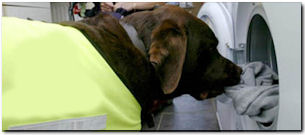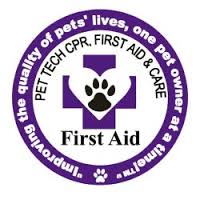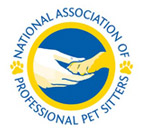Guide Dogs
What are guide dogs?
 Guide dogs are trained to lead the blind or vision impaired. The dog acts as a pilot to direct its owner in a straight line unless directed to turn, while avoiding obstacles in all directions.
Guide dogs are trained to lead the blind or vision impaired. The dog acts as a pilot to direct its owner in a straight line unless directed to turn, while avoiding obstacles in all directions.
How do I get a guide dog?
Blind Veterans are assessed and trained for orientation and mobility. If a guide dog is preferred, information on how to contact guide dog schools is provided. Partnership with the guide dog is provided through non-VA affiliated guide dog schools.
What benefits does VA provide?
Blind Veterans with working dogs are provided veterinary care and equipment through VA Prosthetics and Sensory Aids. VA does not pay for boarding, grooming, food, or any other routine expense associated with owning a dog.
Service Dogs
What are service dogs?
 A service dog is a dog trained to do specific tasks for a person that he or she cannot do because of a disability. Service dogs can pick things up, guide a person with vision problems, or help someone who falls or loses balance easily. For example, a service dog can help a blind person walk down the street or get dangerous things out of the way when someone is having a seizure.
A service dog is a dog trained to do specific tasks for a person that he or she cannot do because of a disability. Service dogs can pick things up, guide a person with vision problems, or help someone who falls or loses balance easily. For example, a service dog can help a blind person walk down the street or get dangerous things out of the way when someone is having a seizure.
Protecting someone, giving emotional support, or being a companion do not qualify a dog to be a service animal. To be a service dog, a dog must go through training. Usually the dog is trained to:
- Do things that are different from natural dog behavior
- Do things that the handler (dog owner) cannot do because of a disability
- Learn to work with the new handler in ways that help manage the owner’s disability
Because the handler depends on the service dog’s help, service dogs are allowed to go to most public places the handler goes. This is the case even if it is somewhere pet dogs usually cannot go, like restaurants or on airplanes. But there are a few exceptions. For example, service dogs can be asked to leave if they are not behaving well.
How do I get a service dog?
Each Veteran’s case is reviewed and evaluated by a prescribing clinician for the following:
- Ability and means, including family or caregiver, to care for the dog currently and in the future
- Goals that are to accomplished through the use of the dog
- Goals that are to be accomplished through other assistive technology or therapy
The Veteran will be informed of an approval or disapproval of their service dog request. Veterans approved for service dogs are referred to Assistance Dogs International-accredited agencies. There is no charge for the dog or the associated training.
What benefits does VA provide?
Veterans with working service dogs are provided veterinary care and equipment through VA Prosthetics and Sensory Aids. VA does not pay for boarding, grooming, food, or any other routine expense associated with owning a dog.
Additional Resources
Non-VA Related Resources
- Assistance Dogs International* (Service Dogs)
- International Guide Dog Federation* (Guide Dogs)
- National Association of Guide Dog Users*
*The links above will take you outside of the Department of Veterans Affairs Website. VA does not endorse and is not responsible for the content of the linked websites. The link will open in a new window.











I thought that it was interesting that service dogs can do certain tasks that their owner can no longer do. I had always thought that it was more of an emotional support thing. It’s good to know that they actually take care of their owner when they can’t do it themselves.